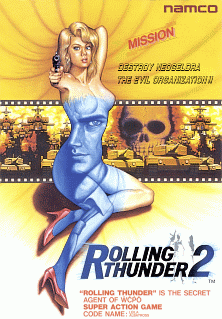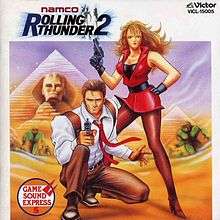Rolling Thunder 2
| Rolling Thunder 2 | |
|---|---|
 European arcade flyer | |
| Developer(s) | Namco |
| Publisher(s) |
Namco |
| Composer(s) | Ayako Saso |
| Platform(s) | Arcade, Sega Genesis |
| Release date(s) |
Arcade Mega Drive/Sega Genesis
|
| Genre(s) | Run and gun |
| Mode(s) | Up to 2 players simultaneously |
| Cabinet | Upright, cabaret, and cocktail |
| Arcade system | Namco System 2 |
| CPU |
2x Motorola 68000 @ 12.288 MHz, 1x Motorola M6809 @ 3.072 MHz, 1x Hitachi HD63705 @ 2.048 MHz |
| Sound |
1x Yamaha YM2151 @ 3.57958 MHz, 1x C140 @ 21.39 kHz |
| Display | Horizontal orientation, raster, 288 x 224 resolution |
Rolling Thunder 2 (ローリングサンダー2 Rōringu Sandā Tsū) is a run and gun arcade game developed and released by Namco for the Namco System 2 hardware in 1990. The game is the sequel to 1986's Rolling Thunder, retaining the same gameplay of its predecessor but adding cooperative gameplay for two players and improved graphics. Unlike the original, which was based in 1968, Rolling Thunder 2 features a more contemporary setting to go along with its more futuristic design, as well as an optionally playable female character. A port for the Sega Genesis/Mega Drive was released in 1991. Both the Mega Drive port and the original arcade game were released for the Wii Virtual Console on December 4, 2007 and October 27, 2009 respectively.
Arcade game
Set in the 1990s, the Geldra organization, thought to had been destroyed during the first game, returns and is destroying several of the world's satellites in outer space. As in the original Rolling Thunder, the players must take control of a member of the WCPO's Rolling Thunder task force.
Two players can now play simultaneously, with Player 1 as female agent Leila and Player 2 as male agent Albatross. Even though they possess different external appearances, including different handguns, the two characters have identical abilities (much like Yūichirō Tomari and Sunday Chin from Namco's own Ordyne, which was released two years earlier and is also a Namco System 2 game). As with the original game, both Leila and Albatross can only take two physical hits from the enemies - and a hit from a bullet or other projectile such as a laser will result in an immediate death for them. Both of them are armed with a default pistol that has only limited ammo; when bullets run out, their guns shall fire a slow "chaser" bullet instead. The players can also upgrade to a semi-automatic machine gun, by entering marked doors - and when entering one of these marked doors, a counter shall appear, which indicates the number of remaining bullets left to be picked up (allowing one player to leave ammo for the other).
The graphics are noticeably improved over the previous game and have a decidedly more futuristic look to go along with the game's modern setting; the game's main enemy characters, the Maskers, who were previously designed to look like hooded terrorists (or Foot Soldiers of the original Teenage Mutant Ninja Turtles arcade game) are now cyborgs. Likewise, the game has more varied stage designs, with the first four stages taking place in a seaside resort in Florida, and the last four stages in a pyramid in Egypt - both locations are actually camouflaged Geldra bases.
Home version
The Mega Drive/Genesis port differs from the arcade original by its inclusion of cut scenes before each stage, consisting of a single static images displayed above a scrolling text that narrates the story's progression; there are also three additional stages not present in the original arcade version, that take place between the arcade's original stages. These stages stand out from their arcade counterparts due to the presence of different upgradeable weapons and end-stage bosses. The Genesis version also features hidden power-ups in unmarked doors such as time extensions, energy recovery, and extra lives.
Much like in the NES port of the original game, a password feature has which uses full sentences instead of numerals and a harder difficulty level after completing the normal game. Both the original Rolling Thunder 2 arcade game and Genesis conversion are available on the Wii Virtual Console service (and the Sega Genesis conversion was again released on there first).
Soundtrack
| Namco Game Sound Express Vol. 5 ~ Rolling Thunder 2 | |
|---|---|
 | |
| Soundtrack album by Ayako Saso | |
| Released | June 21, 1991 |
| Recorded | 1990 |
| Genre | Video game soundtrack |
| Length | 31:55 |
| Label | Victor Entertainment |
A soundtrack album of the arcade version, Namco Game Sound Express Vol. 5: Rolling Thunder 2 was released by Victor Entertainment in 1991 under the catalog number VICL-15005. It contains unused tracks from the arcade version, which were later used in the Mega Drive version of the game (on a Yamaha YM2612, instead of the original YM2151), and was composed and arranged by Ayako Saso.
| Namco Game Sound Express Vol. 5 Rolling Thunder 2 | ||
|---|---|---|
| No. | Title | Length |
| 1. | "Attract" | 0:37 |
| 2. | "Leila & Albatross (Unused) ~ Title" | 0:11 |
| 3. | "Credit ~ Mission 1" | 1:01 |
| 4. | "Round Start Ver.1" | 0:04 |
| 5. | "Theme From Rolling Thunder 2 (Round 1)" | 2:08 |
| 6. | "A Terrible Residence (Round 2)" | 2:47 |
| 7. | "Across The Tube (Round 3)" | 2:39 |
| 8. | "Where Is The Target? (Round 4)" | 2:36 |
| 9. | "Round Clear short Ver." | 0:05 |
| 10. | "Game Over ~ Name Entry" | 0:41 |
| 11. | "Round Select" | 0:12 |
| 12. | "Gimdo Goes to Egypt (Unused)" | 0:29 |
| 13. | "Mission 2 Start (Unused)" | 0:04 |
| 14. | "Round Start Ver. 2" | 0:04 |
| 15. | "View Of Dynamism (Round 5)" | 3:15 |
| 16. | "An Ancient Way (Round 6)" | 3:34 |
| 17. | "Terror For Sale (Round 7)" | 3:21 |
| 18. | "Running Decayed (Round 8)" | 1:47 |
| 19. | "The Final Command (Round 8)" | 2:55 |
| 20. | "Theme From Gimdo (Round 8)" | 1:29 |
| 21. | "Round Clear long Ver. (Unused)" | 0:10 |
| 22. | "Escape!! ~ Ending Theme" | 1:46 |
Reception
The home version of Rolling Thunder 2 was well received. Its mostly highly positive review scores included 92% from Computer & Video Games,[1] 23/25 from GamePro,[2] 85% from Mean Machines,[3] 90% from MegaTech,[4] and, retrospectively, 8/10 from Sega-16.[5] Reviews of the Virtual Console release were often more critical, including being rated 6/10 by GameSpot,[6] 6.5/10 by IGN,[7] and 8/10 by Nintendo Life.[8]
See also
References
- ↑ "Computer and Video Games Magazine Issue 122". Archive.org. Retrieved 2015-11-12.
- ↑ GamePro 29 (December 1991), pages 64-65.
- ↑ "Rolling Thunder 2 - Sega Megadrive - Mean Machines review". Meanmachinesmag.co.uk. Retrieved 2015-11-12.
- ↑ "Out-of-Print Archive • Mega Drive reviews • Rolling Thunder 2". Outofprintarchive.com. Retrieved 2015-11-12.
- ↑ "Sega-16 – Rolling Thunder 2". Sega-16.com. 2004-07-26. Retrieved 2015-11-12.
- ↑ Shau, Austin (2008-01-16). "Rolling Thunder 2 Review". GameSpot. Retrieved 2015-11-12.
- ↑ "Rolling Thunder 2 Review - IGN". Uk.ign.com. 2008-01-14. Retrieved 2015-11-12.
- ↑ "Rolling Thunder 2 (MD) Review". Nintendo Life. Retrieved 2015-11-12.
External links
- Rolling Thunder 2 at Sega's Virtual Console website (Japanese)
- Rolling Thunder 2 at the Killer List of Videogames
- Rolling Thunder 2 at MobyGames
- Rolling Thunder 2 at the Arcade History database